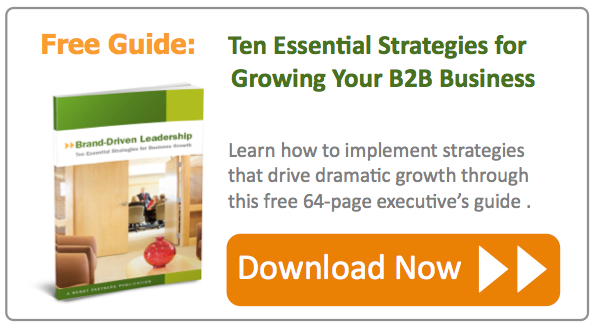A Quick Litmus Test to Evaluate Your Company’s Readiness for Growth
 In order to effectively develop a
business growth strategy for your business-to-business (B2B) company, you must begin with a thorough assessment. After all, you need to understand your present growth capacity before you make plans that rely on a healthy ability to execute.
In order to effectively develop a
business growth strategy for your business-to-business (B2B) company, you must begin with a thorough assessment. After all, you need to understand your present growth capacity before you make plans that rely on a healthy ability to execute.
Still, many CEOs have an innate aversion to assessments, preferring instead to focus on the possibilities of the future, rather than the problems of the present. However, if you’ve ever been hesitant to seek (or perform) an assessment of your business growth readiness, the good news is that you can perform a quick, three-step ‘litmus test’ of your own.
Just like a self-administered home medical exam, it won’t answer every question you have. But it will tell you whether your business is probably healthy when it comes to growth readiness, or whether your business needs to “see a doctor” sooner rather than later.
The Three-Step Litmus Test for Growth Readiness
Okay, so here’s how you can take the three-step self-test for your B2B business:
Step One: Pick a Card, Any Card.
Performing the first step is simple: go to your desk, or the desk of another executive-level colleague who has customer-facing responsibilities. Once you are at the desk, look for that stack of business cards sitting on the corner of the desk. You know the one — it’s a collection of cards you’ve gathered from customer meetings, trade shows, sales calls and various business events.
Pick up the deck of business cards. Now, shuffle it. Then, randomly remove one business card from the stack. Now, you're ready for step two.
Step Two: Connect the Dots from Contact to Relationship.
For step two, begin by reading the information on the business card. Then, ask yourself these questions:
- What is the likelihood that this person’s name, title, company and core contact details (office address, phone number, email address, etc.) were typed into Microsoft Outlook, Gmail or whatever email client your company uses? [Note: Just entering an email address doesn’t count]. If you think the likelihood is good, then search in the system and see if you can find the information.
- What is the likelihood that this same information has also been entered into your company’s Customer Relationship Management (CRM) system, such as Salesforce.com, Microsoft CRM, NetSuite, etc? If you think the likelihood is good, then search in the CRM system and see if you can find the information — and while you're there, verify that it is indeed complete (for example, if the business card showed both a direct phone number and a cell phone number, did both numbers make it into the CRM database?).
- If the information on this contact is entered in your CRM system, which of the following pieces of information can you determine by looking at the contact record?
(a) When this person originally encountered your company.
(b) Where this person originally encountered your company.
(b) Who from your company has been in contact with this person.
(d) What your company needs to do in order to develop a business relationship with this person.
(e) What the currently planned next step is for developing that business relationship, and who is scheduled or tasked with doing it. - Also, if the date you identify when answering 3(a) is more than three months in the past, ask yourself this question as well: What is the likelihood that this person’s contact information is still accurate?
Step Three: From a Relationship to Revenue
For step three, ask yourself these questions (all are still in reference to your original contact from that randomly-chosen business card):
- Is this person a current customer, potential customer, potential partner or potential promoter of your business? Did you just know that off the top of your head, or was that information recorded (and backed up with an explanation) somewhere?
- Is this person receiving regular communications from your company that are appropriate to the nature of your business relationship? If they’re a customer, for example, do they receive customer updates appropriate to their business? If they are a prospect, are you informing them about upcoming seminars, webinars, workshops or white papers? If they are a potential partner, are they being introduced to partner success stories and partner program workshops?
- Is this person and their company being qualified, and if so, where are they in the qualifying process? Do you know whether or not they are a ‘fit’ for your company, and if so, for what products/services that you offer?
- Do you have a clearly defined process with specific, listed steps that will be applied to guide this person and their company through consistent pathways to develop the kind of business relationship you seek with them?
The Answers: Yes, No and “I Don’t Know”
Hopefully, you came through this litmus test in pretty strong shape. If not, then consider this: the only answer to the test questions worse than ‘No’ is ‘I don’t know’.
The other key takeaway is that if you got a good result the first time but don’t believe you could reliably repeat it, then you failed the test, period…regardless of your luck with the first business card you chose.
In the realm of business growth, your business relationships are the equivalent of million-dollar orders. Every single one of them. That’s right - failing this test with any business card (yes, *any* card) is the strategic equivalent of losing the paperwork on a million-dollar (or larger) order.
If you can’t properly manage your business cards (or your inbound emails, or your website inquiries), then you aren’t properly managing your business relationships. And if you aren’t effectively managing your business relationships, then there’s no point in attending more trade shows, sending out more catalogs, or generating more online leads through inbound marketing. After all, the evidence shows that you’ll just let them whither away.
Don’t Worry, You’re Not Alone
Okay, let’s pause for a moment. Chances are, you didn’t feel too good after taking this self-test. It’s such an easy test, and yet it is so easy to fail.
There is one piece of good news: You’re not alone. The number one problem most B2B companies have with sales is lack of effective follow-up, and the number one reason for that is the lack of a clearly defined process - and a properly configured system - to ensure that follow-up happens.
Imagine if the production, accounting or customer service sides of your business ran without processes, systems and clearly defined procedures. Now, ask yourself why you are willing to tolerate this on the sales and marketing side of your business.
The follow-up crisis is particularly acute today, with so many sources of leads (online and offline), and so many ways to connect with new contacts (in-person events, email referrals, LinkedIn connections, etc.).
The research shows that about half of all new sales leads that come into B2B companies are just downright ignored. Ignore one lead for more than about two weeks and you might as well just burn it. Do that for most of your business contacts and you’d be better of simply firing your entire sales team and closing the marketing department, because what you’re doing right now is the same as funding the operations of a restaurant’s commercial kitchen but letting the servers take all of the freshly-prepared food right out to the back and tossing it into the dumpster.
And do you know why most B2B companies don’t follow up on business contacts once they complete tests like this one? Pure and simple, straight-up embarrassment. They feel stupid and sheepish (especially the CEO). Who wants to follow up with someone you had a great conversation with and then dropped, only to pick up their business card six months (or even six years) later? No one. That’s too hard, too frustrating.
So, instead, most companies throw away their existing contacts (or just ignore them, which is constructively the same thing), then promise themselves that they won’t let it happen again. Except, they do let it happen again. And again. And again after that.
There Is a Way Out
We all understand the frustration, embarrassment and mortification that results from coming face-to-face with a dysfunctional (or simply non-functional) business growth engine (i.e., your sales, marketing, strategy and leadership). If you don’t have those four fundamentals in-hand, then you’re not ready to grow.
However, you can overcome this hurdle. The first thing to do, however, is stop looking for new leads. Right now, at least for the moment, you don’t need new leads. You need strategies, systems, processes and people focused on the leads (and all of the other business contacts) that you already have.
Here’s the silver lining in the business growth cloud: Remember that person you met at an industry event six months ago and who you had a great conversation with, only to drop the ball and not follow up until you thought about it today?
Guess what? They won’t mind if you reach out after all of that time. In fact, by taking that step and overcoming your embarrassment (or that of your team), there is a good chance you’ll stand out. After all, did they follow up with you? Is there some alternate universe where they’re not as busy as you are and can’t understand what it’s like to have too much work to do and not enough time to get it all done? Of course not.
Rebuilding Your Company’s Business Growth Engine
What you do need to do is take your test results as a sign that it’s time to get serious about rebuilding your business growth engine. Here four some key steps that you’ll need to take:
1. Proceed with a business growth assessment.
Go beyond this self-test and hire a professional business consultant to come in and fully evaluate your business growth capacity. This includes the four fundamentals of business growth: sales, marketing, strategy and leadership.
2. Commit to a business growth strategy.
Once you’ve got an assessment firmly in hand, you need to develop a growth strategy. That strategy will provide a roadmap for closing gaps in your current internal growth capacity, as well as a model for pursuing clearly-defined target markets and new opportunities.
3. Invest in a business growth platform.
You can’t do the job without the proper tools, and in today’s complex and competitive marketplace, you need to invest in a business growth platform. This will most likely be a cloud-based application environment in which you can define and guide your strategy, implement proper Customer Relationship Management (CRM) workflows, and support marketing automation and digital engagement.
4. Prepare to become a business growth leader.
Change takes leadership, and with the proper guidance from expert business growth consultants and advisors, you can lead your team to success across the board. Take the time (and the training) necessary to evolve your executive skillset and transform your company. into a growth-driven business.
Image Credit: cristiano_betta (Flickr @ Creative Commons)


